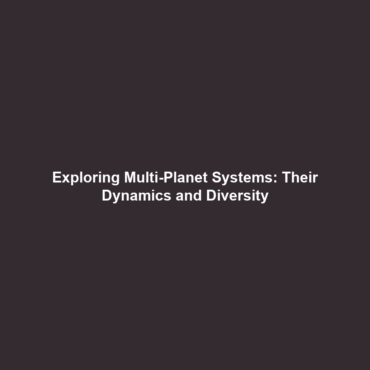Multi-Planet Systems: A Look at Systems with Multiple Planets and Their Orbital Dynamics
Introduction
Multi-planet systems are an exciting aspect of astronomical research that offer insight into the formation and dynamics of planetary systems beyond our own. As more exoplanets are discovered, understanding the orbital dynamics of multiple planets becomes increasingly significant in unveiling the complexities of these systems. The study of multi-planet systems is essential to comprehend how planets interact gravitationally and evolve over time, impacting our broader understanding of exoplanets in the universe.
Key Concepts
Understanding multi-planet systems requires a grasp of several key concepts in astronomy, particularly how different planets orbit their host star in correlation with one another. These interactions can lead to complex and varied orbital patterns.
Orbital Resonance
One of the most significant concepts in the dynamics of multi-planet systems is orbital resonance. This occurs when two or more planets exert a regular, periodic gravitational influence on each other, often resulting in stable configurations and preventing collisions over extensive time scales.
Gravity and Stability
The gravitational forces shared among planets can lead to stability or instability in their orbits. Studying these gravitational interactions helps astronomers predict the long-term behavior of planetary orbits within exoplanet systems.
Applications and Real-World Uses
The implications of understanding multi-planet systems extend beyond theoretical research to practical applications in exoplanet studies. For instance:
- Habitable Zone Assessments: Insights into the orbital dynamics help identify potentially habitable zones around stars where conditions may favor life.
- Astrobiology Research: Understanding these systems aids in biogenic conditions that might exist on distant worlds.
- Space Mission Design: Knowledge of planetary systems is crucial for planning future space missions targeting exoplanets for exploration.
Current Challenges
While substantial progress has been made in studying multi-planet systems, several challenges remain:
- Detection Limitations: Current technologies may not effectively detect smaller planets in distant systems.
- Data Interpretation: The gravitational interactions and influences among planets can be complex and difficult to model accurately.
- Technological Constraints: Limited observational tools restrict our ability to analyze multi-planet systems in detail.
Future Research and Innovations
The future of research related to multi-planet systems looks promising with innovations in technology and observational techniques. Upcoming next-gen telescopes and enhanced data analysis tools are set to revolutionize our understanding of exoplanets and their dynamics. Researchers are also exploring the use of artificial intelligence to analyze complex datasets more efficiently, potentially leading to groundbreaking discoveries.
Conclusion
In summary, multi-planet systems are a vital area of exploration within the broader context of exoplanets. Their orbital dynamics provide essential insights into planetary formation, stability, and potential habitability. Continued research in this field promises to unravel even more secrets of our universe. For more information on exoplanets and their discovery, visit our Exoplanet Discovery page and join the exploration.
